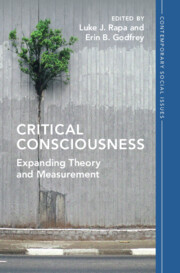Book contents
- Critical Consciousness
- Contemporary Social Issues
- Critical Consciousness
- Copyright page
- Dedication
- Contents
- Figures
- Tables
- Contributors
- Acknowledgments
- Introduction Critical Consciousness Theory and Measurement
- Part I Theory
- Part II Measurement
- Conclusion Expanding Critical Consciousness Theory and Measurement
- Index
- References
Introduction - Critical Consciousness Theory and Measurement
Mapping the Complexity of the Terrain
Published online by Cambridge University Press: 20 April 2023
- Critical Consciousness
- Contemporary Social Issues
- Critical Consciousness
- Copyright page
- Dedication
- Contents
- Figures
- Tables
- Contributors
- Acknowledgments
- Introduction Critical Consciousness Theory and Measurement
- Part I Theory
- Part II Measurement
- Conclusion Expanding Critical Consciousness Theory and Measurement
- Index
- References
Summary
This introduction chapter provides an introduction to critical consciousness and articulates the rationale for why an edited volume on critical consciousness theory and measurement is needed. We highlight the structure of the book, which has two parts: one focused on issues relevant to theory and the other focused on issues relevant to measurement. A brief review of each of the chapters appearing in the volume’s two sections is provided. This chapter concludes with the presentation of a "schema" we provide to support navigating the contents of this volume – and other critical consciousness scholarship– and explicate how this schema represents some of the most complex and challenging issues faced by scholars working in critical consciousness theory and measurement today.
Keywords
- Type
- Chapter
- Information
- Critical ConsciousnessExpanding Theory and Measurement, pp. 1 - 16Publisher: Cambridge University PressPrint publication year: 2023



